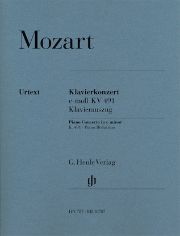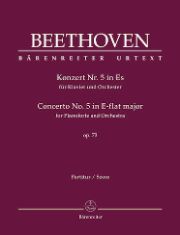On the piano Olympus
Two absolute top works of the repertoire, piano concertos by Beethoven and Mozart, in new editions.

Mozart's Piano Concerto in C minor - admired not only by Beethoven and obviously a source of inspiration for his own in the same key - probably deserves a place of honor among the master's many great concertos. Unlike its sister work in D minor, the solo part is even more consistently interwoven with the orchestra, which leads to symphonic effects, especially in the first movement. In the middle Larghetto, the purest chamber music prevails in dialog with the solo winds. And the finale ends - quite unusually and not as in Beethoven, for example - uncompromisingly in a minor key.
Ernst Herttrich from Henle-Verlag has now reissued the masterpiece. The piano reduction, fingerings, cadenzas and entrances are by András Schiff. In the most literal sense of the word, the publisher has shown a good hand: The orchestral part in the piano reduction is ingeniously kept simple, almost sight-readable and yet sounds colorful. The fingerings are also highly recommendable for the average consumer. This is not always the case when great artists present their own personal playing recipes ...
And finally, Schiff's cadenzas and entrances are also convincing, revealing a great sense of style and practice. Particularly noteworthy: at the end of the large cadenza in the first movement, Schiff quotes the end of the development section verbatim, thus creating a compelling transition into the tutti. All these additions and also some variants from Mozart's pen are unobtrusively integrated into the clearly arranged music. An exemplary edition!
The Bärenreiter publishing house has chosen a completely different approach for the new Urtext edition of Beethoven's Fifth Piano Concerto, which tends to be even more symphonic in scale. And the result presented to us by editor Jonathan Del Mar is also lavish. Not only has he meticulously corrected errors in a large study score, he also provides a separate solo part, a piano reduction and a comprehensive and interestingly illustrated critical commentary.
The editor's care and effort cannot be praised highly enough. The problem, however, lies in the concept: what is the point of a separate part for the piano solo, in which the orchestral part can only be seen from time to time? With this concerto in particular, you always want to have a complete overview. And conversely, in the piano reduction, which Martin Schelhaas has set excellently, the solo part is only included in small print, which is visually unconvincing.
Unfortunately, this new edition is neither practical for someone who wants to learn the solo part nor for the accompanist and is therefore of little help in lessons. The score, on the other hand, teaches you a lot about a work that you thought you already knew too well ...
Wolfgang Amadeus Mozart, Piano Concerto in C minor K. 491, edited by Ernst Herttrich, piano reduction, fingering, cadenzas and entrances by András Schiff, HN 787/ EB 10787, € 18.50, G. Henle, Munich/Breitkopf & Härtel, Wiesbaden 2015
Ludwig van Beethoven, Concerto No. 5 in E flat major op. 73 for piano and orchestra, edited by Jonathan Del Mar; score, BA 9025, € 45.50; piano reduction by Martin Schelhaas, BA 9025-90, € 24.95; critical report, BA 9025-40, € 41.50; Bärenreiter, Kassel 2015








